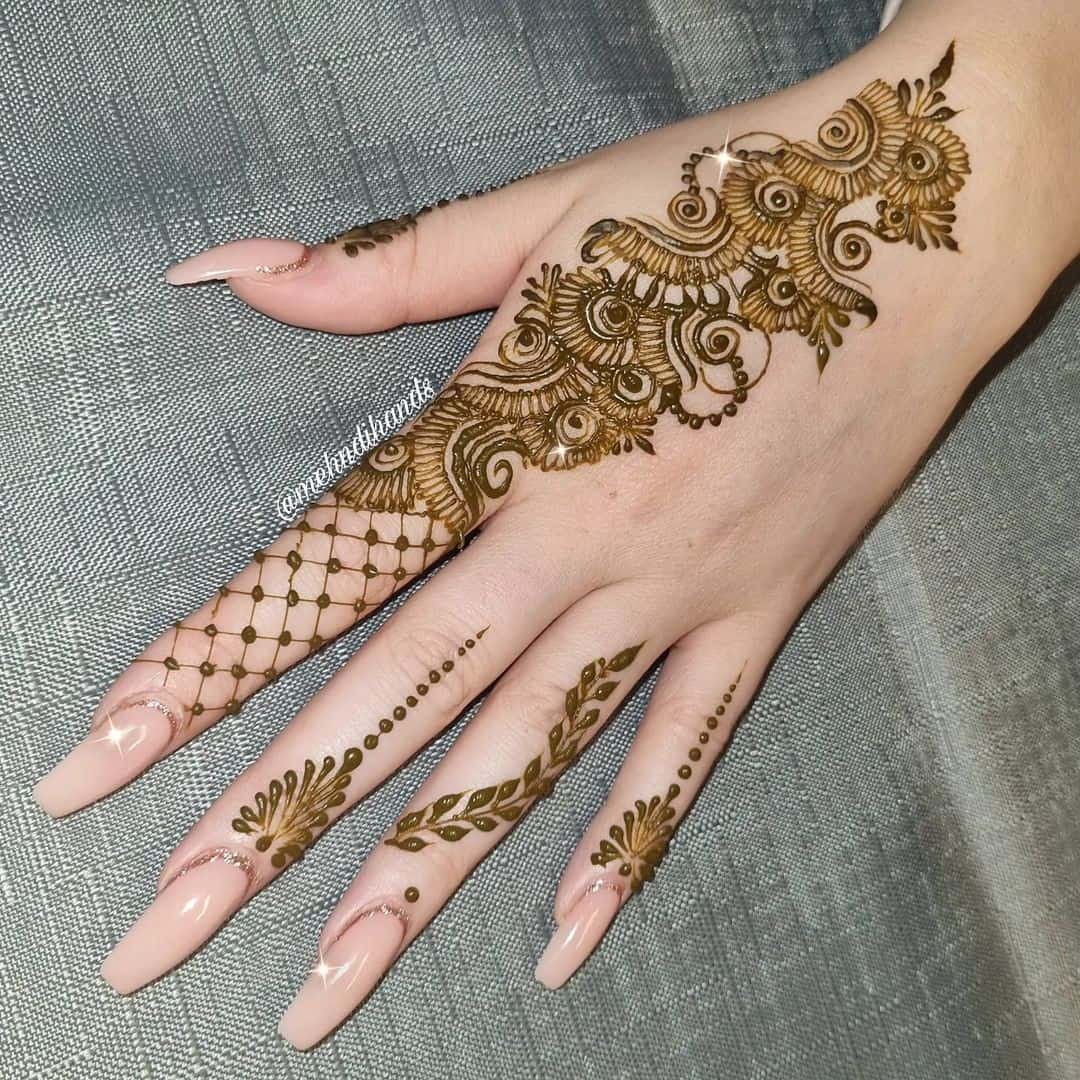Henna Vs. Tattoo (Process Of Creating, Duration, Pain Level, Design Possibilities, Skin Impact)
Getting body art done on your skin is a major decision, especially when it comes to making a decision between a temporary or permanent option. Before one makes up their mind, it is always important to do proper research and figure out which option suits their wishes, needs, and even possibilities, which can be a difficult job. Unless one is already henna or tattoo kind of person, it is even tricky to know where to start the research.
That is why we’ve decided to provide you with an in-depth comparison of these two body art forms; we’ll put henna and regular tattoos right next to each other and provide you with all the necessary information needed to help you make a final decision. So, without further ado, let’s jump right into this interesting topic!
Henna Vs. Tattoo: The Key Similarities
Before we start, let’s just go over a few quick definitions of henna and regular tattoos, in case one is confused about what one or the other is.
So, henna tattoos are temporary tattoos made using dye from the henna plant powder. The plant powder is often mixed with water to create a paste, which is then pushed out of a small piping bag onto the skin.
Regular tattoos, on the other hand, are permanent. They’re done using a tattoo machine gun, tattoo needles, and tattoo ink. The tattoo gun pishes the ink into the dermis skin layer, creating lifelong-lasting body art.
The Similarities
When it comes to similarities between henna tattoos and regular tattoos, we have to say right away; that there aren’t really many to talk about. The only similarity between henna and regular tattoos is that both are being placed on/on the skin; both are considered a form of body art.
However, the technique in which they’re applied is completely opposite, and the dye that it’s used to do so is also completely different. One is temporary, and the other is permanent, which is probably the main difference. There are other, numerous differences, which we’ll cover in the following paragraphs.
Also Read: Best Henna Tattoos 2022: Everything You Need To Know + Best Design Ideas
Henna Vs. Tattoo: The Main Differences

The Process Of Creating
Henna tattoos, as we’ve mentioned, are created using henna plant powder mixed with water to create a thick paste. The paste is then pushed out of the piping bag onto the skin, where it dyes the skin in the pattern in which it has been pushed out. Henna tattoos are known for the intricate, mesmerizing patterns loved all around the world.
Regular tattoos are done using a tattoo gun, needles, and tattoo ink. The gun and needles push the ink into the dermis layer on the skin, which makes them permanent. Henna tattoos are placed onto the skin, so the dye vanishes after some time, leaving the skin clear again. Regular tattoos stay in the skin for as long as one wants, either the whole life or until they get the tattoo removed via laser removal method.
Both types of tattoos require highly skilled professionals, despite being different in application and duration. That could be a similarity to point out. However, the processes in which these body arts are created are completely different, and as such, carry different risks and consequences.
Also Read: Temporary Vs. Permanent Tattoos: Which One Should You Get?
Duration of the Tattoos
Henna tattoos are temporary, as we’ve mentioned. This means they last only as long as the henna dye stains on the skin last. A henna tattoo can typically last between 4 and 7 days. If one is using the highest quality henna dye, mixed with other ingredients like essential oils or tea leaf powder, the tattoo can last even up to 12 days. After this period, the dye starts to fade and eventually completely disappear.
When it comes to regular tattoos, they’re always created with permanence in mind. Because the tattoo inks are placed into the skin layer known as the dermis, they can stay there for as long as one wants. People usually have their tattoos for a lifetime, but some choose to get rid of them utilizing certain tattoo removal options, like laser tattoo removal. In that case, one can get rid of a tattoo after several tattoo removal sessions. However, in some cases, even laser tattoo removal can’t get rid of the ink in the skin completely, so there are always slight indications of a tattoo in the skin.
The Pain Issue
Creating a henna tattoo is completely pain-free. Because the henna plant powder paste is placed onto the skin, there is no pain involved, which is great if a person fears the pain and discomfort of the regular tattoo. With henna tattoos, there is also no healing process. The dye simply dries on the skin leaving a dyed skin pattern that fades away after a few days.
On the other hand, regular tattoos are treated as wounds when freshly done. That is because the tattoo gun pushed the needles into the skin, where the needle pokes the skin at a quick rate, thousands of times in a minute. This skin puncturing creates an ‘open wound’, which of course can be pretty painful. The pain levels of the regular tattoo are often determined by the location of the tattoo, the size of the design, and of course, the skillfulness of the tattoo artist.
Once a tattoo is done, it needs to heal, like any other wound. The healing process is pretty straightforward; the tattoo needs to stop bleeding and oozing to dry out and close. From there the skin will start to regenerate, creating a crust that will start falling off once the new skin layer underneath is fully formed and the tattoo is healed.
A healed tattoo is mat in color and shows no signs of healing anymore. It can take up to a month, sometimes even longer for a tattoo to completely heal. The healing process can cause some discomfort, like itching and general pain in the first few days. However, if taken care of properly, the tattoo healing process is generally painless.
Also Read: Tattoo Pain Chart (Scale): What Is The Most (Least) Painful Place (Male & Female)
Design Possibilities
Because henna tattoos are created using the henna plant powder mix, the design options are limited to pattern work. The pattern work, of course, varies and features a lot of lining and dots. However, that is about it when it comes to henna design possibilities. It can be incredibly hard to create more intricate designs, with different colors or shading when using a piping bag to push out the henna paste onto the skin.
Regular tattooing, on the other hand, offers a plethora of design possibilities. Regular tattoo work provides endless possibilities because it is more detailed and intricate and thanks to the thin, quick-working needles, mesmerizing.
The tattoo artist creates a tattoo design, prints sit onto the skin, and then outlines the tattoo using the tattoo gun and needle, as well as the ink. Then, the tattooist is free to color, shade, blend and do all kinds of other techniques to create almost lifelike tattoos. The choice of color, as well as the complexity of the tattoo, is completely unlimited when it comes to regular tattooing.
Also Read:
Skin Impact and Risks
Henna tattoos, when done using proper henna plant powder, have no skin impact at all. Natural henna powder simply dyes the skin temporarily and fades away. There is no pain infliction and the overall henna process is pretty quick and straightforward.
However, when using random pre-mixed henna pastes bought in some stores or random online sites, you can expect to have certain skin reactions. Some henna pastes, like those advertised as ‘black henna pastes’, are created using paraphenylenediamine (PPD).
This is a chemical that is generally controlled in certain products, like hair dye. However, because henna paste/powder is a non-controlled product, the amounts of the PPD chemical exceed the allowed amounts, which can then cause skin chemical burns, allergic reactions, skin swelling, blistering, and so much more. The remaining skin scarring is generally permanent (in the shape of pattern outlining).
To avoid any of these things happening, we strongly advise against buying black henna paste or powder. Real, natural henna dye is never black; because it is made from powdered plants, henna is generally between orange and brown in color. That is how you can know whether henna contains toxic chemicals; the darker the color, the greater the risk.
When it comes to regular tattoos, the risks are definitely more serious. Because the ink is pushed into punctured skin, there are numerous risks and consequences if the job isn’t done correctly. Some of the risks include;
- Contamination and exposure to bloodborne diseases
- Skin infections
- Inflammations
- Ink leaking and tattoo raising
- Rashes and allergic reactions
- MRI complications (due to ink ingredients)
The majority of these risks and complications almost never occur if the tattoo artist knows what they’re doing. That is why the tattoo parlors need to be disinfected at all times, just like the tattoo equipment, tools, as well as the tattoo artist’s hands. The tattoo artist will tattoo with gloves on, using clean, sterilized tools.
Then, they will clean and sterilize your tattoo, wrap it up and leave you to take care of it in the aftercare process. That is also when, if done incorrectly, tattoos can get infected. That is because people don’t clean their tattoos, expose them to bacteria and germs, and so much more.
So, all of the risks and complications can be avoided by simply getting a tattoo done by a professional, skilled tattoo artist, and by taking care of the tattoo in the aftercare process by following the tattooist’s recommendations and advice.
Final Thoughts
Henna tattoos and regular tattoos are two completely different forms of body art. Though both incredibly interesting and beautiful, they don’t last the same time and are done in completely different manners and techniques. Both henna and regular tattoos carry certain pros and cons, so we can’t really say which option is truly better for anyone.
Some people fear tattoo pain but want to experience what it is like having a tattoo, in which case henna tattoos are perfect. Others want to have complex, intricate designs on their bodies that will last them a lifetime, in which case regular tattoos are irreplaceable. Whatever you decide to do and go for, always make sure to have your body art done by professionals, skilled experts.
Also Read: Inkbox Vs. Henna: What’s The Difference?
- Safe, non-toxic plant-based temporary tattoos made with 100% high-definition printing for a realistic look without the pain
- Easy to apply and remove - just stick for 20 seconds then take off
- Set includes 5 sheets with 17 fun, delicate designs like hearts, cats, smiles, suns, moons, and more
- Waterproof and long-lasting - stays on up to 2 weeks of wear
- Fashionable for women, men, girls and boys
- Place on arm, wrist, neck, leg, finger, waist, foot and more
- Great for parties, birthdays, and showing your unique style








